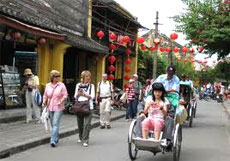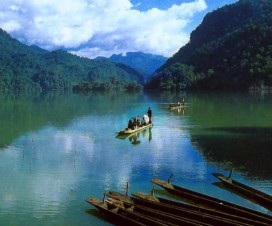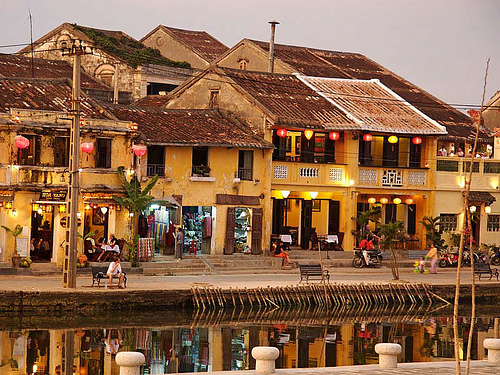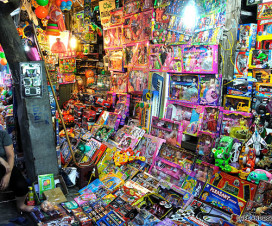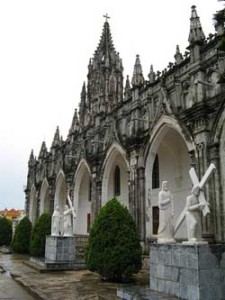
Tra Co Church was built in 1880. It is a massive structure decorated with beautiful reliefs. It houses an 80-year-old bell.
What do you think of when you read the fol-lowing lines about Viet Nam by the famous Vietnamese poet To Huu:
How amazing my country is!
Lean against Truong Son Mountain Range
Reach to Truong Sa (Spratly) Islands
From north-eastern most Tra Co with populous forest
To southernmost Ca Mau with mangroves
If you are a traveller cherishing your exploration of the country, you will most likely share the same impressions with your family and friends when you talk about your experience enjoying the beauty of Viet Nam.
Let’s start the journey from Tra Co, a beautiful beach in the country’s northeastern most province, Quang Ninh.
The winding road to Tra Co doesn’t dissuade visitors from continuing the journey thanks to sweeping views of the beautiful landscape. Travellers can also go to Tra Co by boat from Hai Phong or from Bai Chay, another coastal city in Quang Ninh Province.
The locality is endowed with a 17km-long coast line and beautiful beaches from Sa Vy to Mui Ngoc. The full length is one of the most attractive beaches in Viet Nam.
While Nha Trang Beach attracts visitors with its beauty reminiscent of a chic modern girl, Tra Co beach looks like a country girl because its beauty has not been altered from its natural state by development.
The wild beauty of Tra Co allows people to enjoy the peaceful and slow flow of life in the province. Taking a stroll along the white-sand beach, listening to the sound of waves crashing, and freeing your mind as you look up at the immense blue sky and the never-ending sea is a simple and enjoyable way to pass the day.
There are four seasons in Tra Co with comfortable temperatures throughout, neither too hot in the summer nor too cold in the winter. The average temperature is about 220C, going up to about 26-280C in summer. In the moderate heat of summer, the cool and clean sea water beckons to would-be swimmers and waters sports enthusiasts.
Visitors are recommended to wake early one morning to travel the 6km to Con Mang to watch the immense red flame of the sun slowly rising to welcome the day. Likewise, as the day wanes they can find a place to relax along the beach to enjoy the sunset. Lovers and groups of friends alike will find enjoyment as they share in the quiet beauty of the pristine sands and feel their souls mesh in harmony with nature and escape from the troubles and sounds of daily life.
Not far from Con Mang is Sa Vy, the country’s northeastern most point, where people can look out across neighbouring China. At Sa Vy point, visitors can pose for a photo next to three popular tree-shaped sculptures. Lines from the poem by To Huu are posted on it.
Another worthy stopping point is Tra Co Church, an old piece of architecture built in 1880. It is a massive structure decorated with beautiful reliefs and an 80-year-old bell. In 1995, the damaged reliefs were restored, returning the structure to its original glory.
The nearby Tra Co Temple is another popular destination which is the pride of the local people. It was built in the 15th century but has gone through some changes over time. However, its typical architectural and decorative features have been maintained.
Villagers worship their ancestors at the temple. According to legend, the ancestors were originally from the northern coastal town of Do Son (Hai Phong City now) and migrated to Tra Co more than 600 years ago. Six ancestors in particular are still worshipped here for their great contributions to the establishment of the village.
Vietnamese style
Tra Co Temple features typical Vietnamese artchitectural style. Although it was built in a border area with China and could easily have included features from the country’s northern neighbour, the style is distinctly Vietnamese, confirming that the Vietnamese people have long respected their national cultural identity.
After nearly 600 years, the temple still sits as the witness to the country’s ups and downs and acts as a vivid story teller who helps generations of Vietnamese learn more about their traditions.
Tra Co Temple is similar in style to many others in the Hong (Red) River Delta. Decorations include various patterns of four supernatural creatures including dragons, unicorns, tortoises and phoenixes, along with God and humans.
The temple inspired Vietnamese composer Nguyen Cuong to write the song Mai Dinh Lang Bien (Temple Roof in Coastal Village) that has left a deep impression in the souls of many Vietnamese people.
Historian Do Van Ninh said that Tra Co Temple proves the territorial expansion process of the Vietnamese and the connection between the border coastal area with other areas of the country.
Annual festival
People visiting Tra Co during late lunar May and early June can take the opportunity to join in the village’s annual festival. From May 30 to June 6 a variety of activities are held to celebrate the village.
Prior to the festival, on May 25, a festive procession from Tra Co begins a return journey to the original hometown of Do Son to honour the ancestors there. It takes them about three days by boat to make the trip to the hometown but only two days to return. They belive that the festive procession can travel faster thanks to support from the ancestors.
On the night of May 30, the temple is bright with candles, lights and smells of burning incense. Locals come to pray for health, wealth and a properous year.
The following morning, a ceremony to escort the King to sea takes place. Dozens of people donned in traditional attire join the procession, some playing musical instruments and others holding colourful flags or weapons. A crowd of people follow creating an exciting atmosphere.
During the festival, the village also hosts activities such as a cooking competition where people can enjoy local specialities, and dancing competitions.
The ritual has been preserved for hundreds of years, consistently enriching the spiritual life of the coastal village residents.
One tourist from Ha Noi, who enjoyed the festival during a holiday to Tra Co, said that she was very impressed by the way the locals preserved their traditions.
“Their performance at the festival helped me learn more about Vietnamese culture, especially the culture in a coastal areas,” she said.
Source: VNS
Collected by Vietnam hotel

